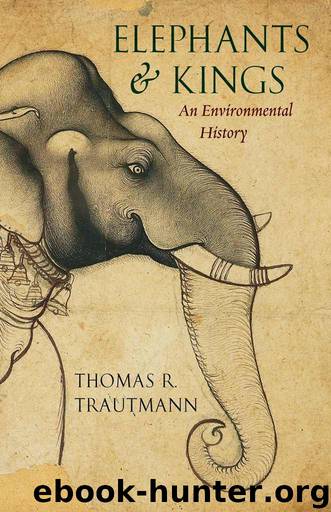Elephants and Kings: An Environmental History by Trautmann Thomas R

Author:Trautmann, Thomas R. [Trautmann, Thomas R.]
Language: eng
Format: epub
Publisher: University of Chicago Press
Published: 2015-08-02T18:15:00+00:00
6
The Near East, North Africa, Europe
THE INSTITUTION OF THE WAR ELEPHANT IN South Asia expanded at first within the natural habitat of the wild Asian elephant. The war elephant, I have shown, was a crucial factor within a model of kingship and warfare developed in North India and then drawn upon by newly forming kingdoms in the orbit of the Mauryan empire. This model of kingship expanded—alongside Buddhism, Jainism, and Hinduism—ever further into an elephant-rich terrain, among polities receptive to new forms of kingship.
I now look westward to examine the amazing phenomenon of non-Indian kings taking up the war elephant, in terrains from which Asian elephants had long since become extinct and where there were no wild elephants or only wild African elephants. I have already indicated how costly it was to capture, train, and maintain the large male tuskers used for warfare. In regions to the west of India these costs escalated, but so did the rarity value of the war elephant. Accordingly, a diverse variety of kings in this region—Persian, Greek and Macedonian, Carthaginian, Roman, Ghaznavid Turk—thought it worth their while to go to extraordinary lengths to acquire war elephants and deny them to their enemies. As we shall see, the nub of the matter was access to the specialized knowledge and skills of Indian elephant men: hunters, trainers, drivers, and physicians. Traces of how this knowledge travelled to and was acquired by monarchs toward the west are scarce yet distinct in documents that record the conjuncture which brought about this unexpected arms race.
Scullard has mapped this development by locating battles and sieges in which elephants were used. In Fig. 6.1 I reproduce his map, to which I have added further battles and sieges, notably those among the Sassanians of Persia,1 and the Ghaznavids of Central Asia.2 All, except only the battle of the Jhelum in India, lie outside the habitat of wild Asian elephants and are shaped, therefore, by conditions of scarcity, great cost, and difficulty of acquiring new stock. The map shows seventy-two battles and sieges for which we have reliable records, over a period extending from 530 BCE to 1117 CE. If we had sufficient evidence, the map could be extended to cover South and Southeast Asia, where battles and sieges using war elephants would have been much more numerous. This, then, is the western periphery of the object of study. It extends entirely beyond the range of wild Asian elephants over a period of about 1600 years, made all the more impressive because of the extraordinary efforts it will have taken to supply and replenish the region with stocks of the animal.
Achaemenids and Assyrians
The Achaemenid empire of Persia (c. 550–330 BCE), the largest the world had seen to its time, must have been an inspiration for the formation of the Nanda and Maurya empires, even if there are few direct connections in surviving records, the evidence being circumstantial and thin. One such connection is the inclusion of a province of India called Gandāra (= Skt.
Download
This site does not store any files on its server. We only index and link to content provided by other sites. Please contact the content providers to delete copyright contents if any and email us, we'll remove relevant links or contents immediately.
The Lonely City by Olivia Laing(4772)
Animal Frequency by Melissa Alvarez(4430)
All Creatures Great and Small by James Herriot(4277)
Walking by Henry David Thoreau(3926)
Exit West by Mohsin Hamid(3796)
Origin Story: A Big History of Everything by David Christian(3666)
COSMOS by Carl Sagan(3593)
How to Read Water: Clues and Patterns from Puddles to the Sea (Natural Navigation) by Tristan Gooley(3434)
Hedgerow by John Wright(3320)
How to Read Nature by Tristan Gooley(3294)
The Inner Life of Animals by Peter Wohlleben(3286)
How to Do Nothing by Jenny Odell(3268)
Project Animal Farm: An Accidental Journey into the Secret World of Farming and the Truth About Our Food by Sonia Faruqi(3192)
Origin Story by David Christian(3170)
Water by Ian Miller(3158)
A Forest Journey by John Perlin(3044)
The Plant Messiah by Carlos Magdalena(2901)
A Wilder Time by William E. Glassley(2837)
Forests: A Very Short Introduction by Jaboury Ghazoul(2815)
